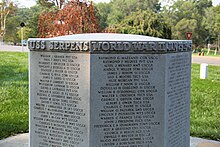USS Serpens (AK-97)
{{Infobox Ship Characteristics
 USS Serpens (AK-97) moored pierside, date and location unknown.
| |
| History | |
|---|---|
| Name | Serpens |
| Namesake | Serpens |
| Owner | |
| Operator | |
| Ordered | as a type (EC2-S-C1) hull, MCE hull 739 |
| Builder | California Shipbuilding Corporation, Wilmington, California |
| Laid down | 10 March 1943 |
| Launched | 5 April 1943 |
| Sponsored by | Mrs. H.P. Needham |
| Acquired | 19 April 1943 |
| Commissioned | 28 May 1943 |
| Stricken | 10 March 1945 |
| Identification | Hull symbol:AK-97 |
| Honors and awards | 1 battle star (World War II) |
| Fate | Destroyed by explosion, 29 January 1945 |
| General characteristics [1] | |
| Class and type | Crater-class cargo ship |
| Displacement |
|
| Length | 441 ft 6 in (134.57 m) |
| Beam | 56 ft 11 in (17.35 m) |
| Draft | 28 ft 4 in (8.64 m) |
| Installed power | |
| Propulsion |
|
| Speed | 12.5 kn (23.2 km/h; 14.4 mph) |
| Complement | 206 officers and enlisted |
| Armament |
|
USS Serpens (AK-97) was a United States Coast Guard-manned Crater-class cargo ship in the service of the United States Navy in World War II. It was the first ship of the Navy to have this name. It is named after Serpens, a constellation in the northern hemisphere.
Serpens was laid down on 10 March 1943 as the liberty ship SS Benjamin N. Cardozo (MCE hull 739) by California Shipbuilding Corporation, Wilmington, California, under a Maritime Commission contract; launched on 5 April 1943, sponsored by Mrs. H.P. Needham; transferred to the Navy on 19 April 1943, renamed Serpens and designated AK-97; and commissioned at San Diego on 28 May 1943, Lt. Comdr. M.J. Johnson, USCGR, in command.
Service history
World War II, 1943–1944
Following shakedown off Florida, Serpens loaded general cargo at Alameda and, on 24 June, sailed west to assume provision ship duties in support of operations in the Solomons. By mid-July, she was in the Tonga Islands. At the end of the month, she was en route from New Caledonia to New Zealand; and, by mid-August, she had emptied her holds at Wellington. She then took on more cargo; returned to New Caledonia; and commenced a series of short hauls to Vitu Levu, Tutuila, Penrhyn, Bora Bora, Aitutaki, and Tongatapu.
On 9 November, Serpens returned to New Caledonia. In early December, she moved into the southern Solomons; and, after completing a Florida Island-Banika Island run, she stood off Lunga Point, Guadalcanal, to load cargo for Bougainville. During January 1944, she completed two runs into Empress Augusta Bay. In February, she was ordered back to New Zealand for dry-docking before loading dry provisions.
For the next four months, Serpens delivered consignments to bases in the New Hebrides and the Solomons, returning to New Zealand to reload only once. In July, she was at Purvis Bay for the installation of SF-1 radar. She then resumed operations and, through October, carried general cargo and rolling stock between ports and anchorages in the Solomons. In mid-November, she loaded repairable vehicles from the Russells and from Guadalcanal and sailed for New Zealand where, after offloading, three of her holds were converted for ammunition stowage.
Destruction, 29 January 1945
Late in December 1944, the Liberty ship commenced loading at Wellington, finished it at Auckland, and returned to the Solomons in mid-January 1945. Late in the evening on 29 January 1945, Serpens was anchored off Lunga Beach. The commanding officer and seven others, one officer and six enlisted men, were ashore. The remaining 198 members of Serpens crew and 57 members of an Army stevedore unit were on board the ship, loading depth charges into her holds. During the loading, Serpens exploded. The force of the explosion was so great that it killed an Army soldier who was ashore. After the explosion, only the bow of the ship was visible. The rest had disintegrated, and the bow sank soon afterward. Only two sailors aboard survived the incident. The cause of the explosion was never completely determined. The loss of the Serpens remains the largest single disaster ever suffered by the U.S. Coast Guard.
Awards

Serpens earned one battle star for her World War II service. A mass grave for 250 of her dead was dedicated at Arlington National Cemetery in 1950.
References
 This article incorporates text from the public domain Dictionary of American Naval Fighting Ships. The entry can be found here.
This article incorporates text from the public domain Dictionary of American Naval Fighting Ships. The entry can be found here.- Atkinson, Rick (2007). Where Valor Rests. Washington, D.C.: National Geographic. ISBN 1-4262-0089-7.
External links
- Photo gallery of USS Serpens at NavSource Naval History
- The USS Serpens Commemorative Website
- USS Serpens Photo Gallery
